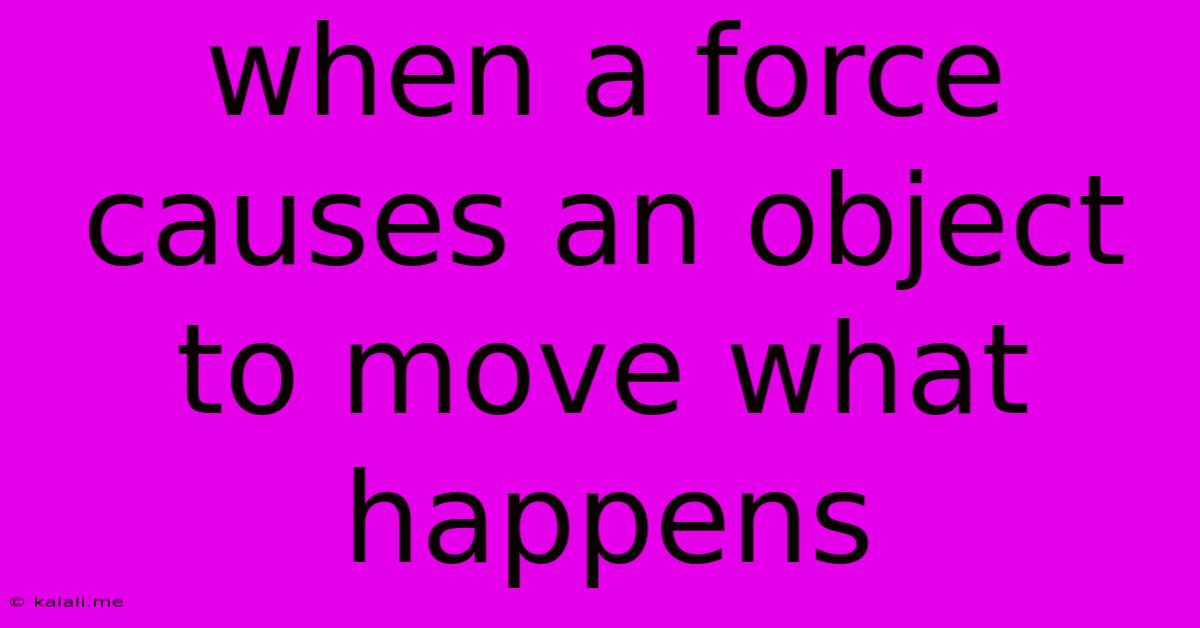When A Force Causes An Object To Move What Happens
Kalali
May 22, 2025 · 3 min read

Table of Contents
When a Force Causes an Object to Move: Understanding Newton's Laws
When a force acts upon an object, causing it to move, several things happen, all governed by the fundamental principles of physics, specifically Newton's Laws of Motion. This seemingly simple question opens the door to a fascinating exploration of how forces interact with objects and influence their motion. This article will delve into the mechanics of this interaction, explaining the concepts in an easy-to-understand manner.
What Happens When a Force Causes an Object to Move?
The most immediate consequence is that the object's velocity changes. Velocity is a vector quantity, meaning it has both magnitude (speed) and direction. A force can change either the speed or the direction of the object's movement, or both. This change in velocity is known as acceleration.
Let's break this down further using Newton's three laws of motion:
Newton's First Law: The Law of Inertia
This law states that an object at rest stays at rest and an object in motion stays in motion with the same speed and in the same direction unless acted upon by an unbalanced force. This means that without an external force, a stationary object will remain stationary, and a moving object will continue moving at a constant velocity. The force is what initiates the change in the object's state of motion.
Newton's Second Law: The Law of Acceleration
This law quantifies the relationship between force, mass, and acceleration. It states that the acceleration of an object is directly proportional to the net force acting on it and inversely proportional to its mass. This is often expressed mathematically as: F = ma, where F is the net force, m is the mass, and a is the acceleration. A larger force will result in a greater acceleration, while a larger mass will result in a smaller acceleration for the same force. This law explains how much the object's velocity will change.
Newton's Third Law: The Law of Action-Reaction
This law states that for every action, there is an equal and opposite reaction. When a force is applied to an object, the object exerts an equal and opposite force back on the source of the force. For example, when you push a wall, the wall pushes back on you with an equal force. This explains the interaction between the force and the object.
Factors Influencing Movement:
Beyond Newton's Laws, several other factors influence how an object moves when a force is applied:
- Friction: This resistive force opposes motion between surfaces in contact. Friction reduces the acceleration of an object and can even bring it to a stop.
- Air Resistance (Drag): This force opposes the motion of an object through a fluid (like air or water). It increases with the speed of the object and its surface area.
- Gravity: This attractive force pulls objects towards each other. Near the Earth's surface, gravity causes objects to accelerate downwards at approximately 9.8 m/s².
Examples in Everyday Life:
Understanding these principles helps explain everyday occurrences:
- Pushing a shopping cart: You apply a force to accelerate the cart. Friction and air resistance oppose the motion.
- Throwing a ball: You apply a force to accelerate the ball. Gravity pulls it back down, and air resistance slows its movement.
- Driving a car: The engine applies a force to accelerate the car. Friction, air resistance, and road conditions all affect the car's motion.
In conclusion, when a force causes an object to move, it results in a change in the object's velocity (acceleration), governed by Newton's laws of motion. The magnitude of the acceleration depends on the size of the force and the mass of the object. Other factors, such as friction and air resistance, also play significant roles in determining the object's final motion. Understanding these fundamental principles is crucial for comprehending the world around us.
Latest Posts
Latest Posts
-
Duty Free Paris Charles De Gaulle
May 22, 2025
-
How To Say Mom In Japanese
May 22, 2025
-
How To Turn Dirt Into Grass Minecraft
May 22, 2025
-
How To Make Your Alarm Louder
May 22, 2025
-
How To Delete Linkedin Account Without Password
May 22, 2025
Related Post
Thank you for visiting our website which covers about When A Force Causes An Object To Move What Happens . We hope the information provided has been useful to you. Feel free to contact us if you have any questions or need further assistance. See you next time and don't miss to bookmark.